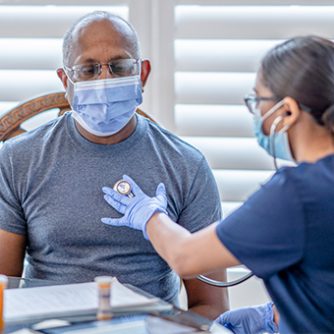

Jim Kelly was well-acquainted with pain. Diagnosed with multiple myeloma in 2008, he underwent chemotherapy and a stem-cell transplant to treat the disease. But it could never be cured, and the pain and complications caused by the blood cancer never seemed to stop.
No one witnessed Jim’s chronic pain more closely than his wife Ann, who became his caregiver.
“He was in and out of the hospital for years,” Ann says. The nerve damage Jim sustained caused pain and numbness, and the chemotherapy severely weakened his immune system. As the years went on, the disease caused other, lingering issues: The nerve pain spread to the right side of his face, and caused spinal stenosis (a narrowing of the spine that can add pressure to the surrounding nerves). He endured shingles that spread to his brain.
“Jim was pounding the bed in agony, but his doctor at the time was saying there was nothing more he could do for him,” Ann remembers. “That’s when I called Samaritan and said, ‘Can you help me? I’m ready to pull my hair out.’”
Jim qualified for Samaritan’s palliative care program which would address the pain, symptoms, and stresses of his serious illnesses. What followed was the building of a relationship built on communication, compassion, and trust. Stephen Goldfine, MD, DABFP, CAQGM, DABHP and Chief Medical Officer of Samaritan, consulted with Jim and Ann on how to best manage Jim’s pain and symptoms.
“I felt such relief,” Ann says. “I couldn’t believe someone finally believed the level of pain my husband was in for years. Dr. Goldfine is empathetic, he’s kind. He believed us. Samaritan recognizes that a patient should never be in agony like Jim was, no matter their stage of life.”

Dr. Goldfine and the Samaritan care team monitor Jim’s pain level and coordinates his medications, including his medical marijuana license. Ann and Jim meet with Dr. Goldfine via telemedicine appointments, where they discuss his needs, any specific issues or areas of pain, mobility issues, and more. When Jim wished to cut back on some of his pain medication, Dr. Goldfine, with Ann’s help, closely monitored the results to better understand what dosages would best help manage Jim’s pain. The care team also helped Jim and Ann document their goals of care.
But Jim wasn’t the only patient being tended to by Samaritan. As his primary and only caretaker, the Samaritan care team was concerned for Ann’s mental and physical health as well – especially once she was diagnosed with early-stage lymphoma.
“I’m one of those strong crazy people who think they can do everything,” Ann says. “But Dr. Goldfine expressed concern about me as Jim’s caretaker – and that in and of itself is a relief.” Ann had been taking care of Jim for so long, she was an expert on caregiving; she had even run a local support group for caregivers. But “I was helping everyone but myself,” she says. “Jim can get angry sometimes, understandably; sometimes I’m more like a mother to him and I can resent that too. Samaritan offered individual counseling sessions for me – just having a chance to talk, and having someone listen, is important.”
Under Dr. Goldfine’s care, Jim’s pain is now at a manageable level, and Ann is mindful of taking care of herself as well as her husband.
“There should be a Samaritan in every place, there should be a doctor like Dr. Goldfine in every state and every town,” Ann says. And she knows firsthand the need for support for hospice and palliative care patients, as well as their caregivers, is great – within her Mount Laurel community, Ann says she knows five caregivers taking care of a loved one full-time.
“It’s scary how great the need is,” she says. “But Samaritan is one of the lights; it’s the humanity. Samaritan reminds you that there are some good and kind people out there.”